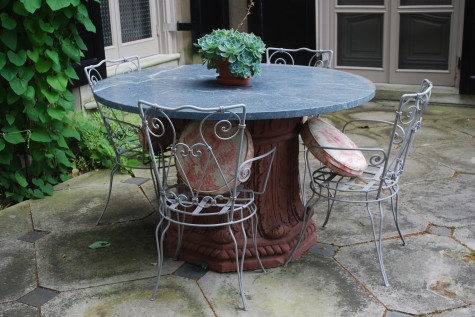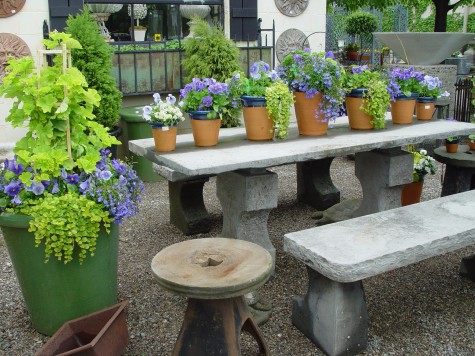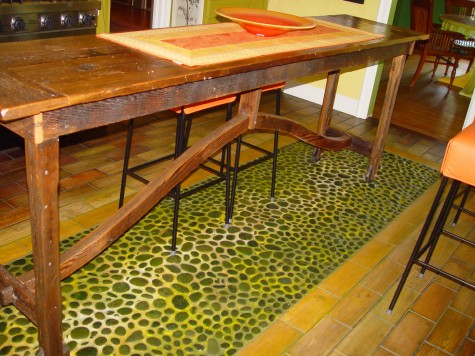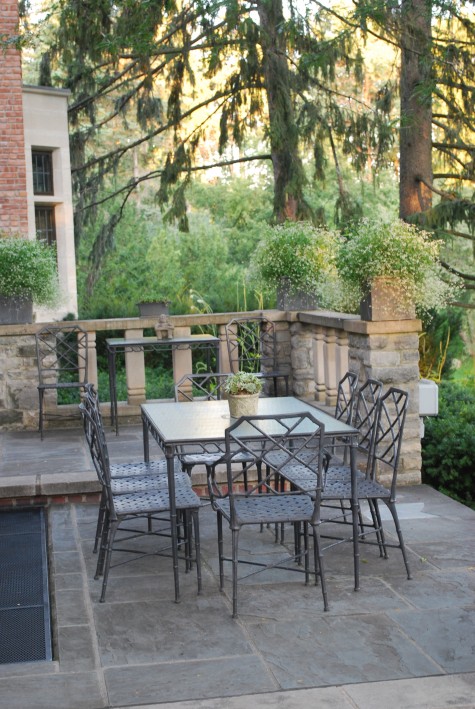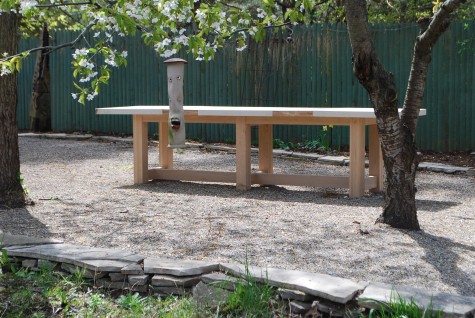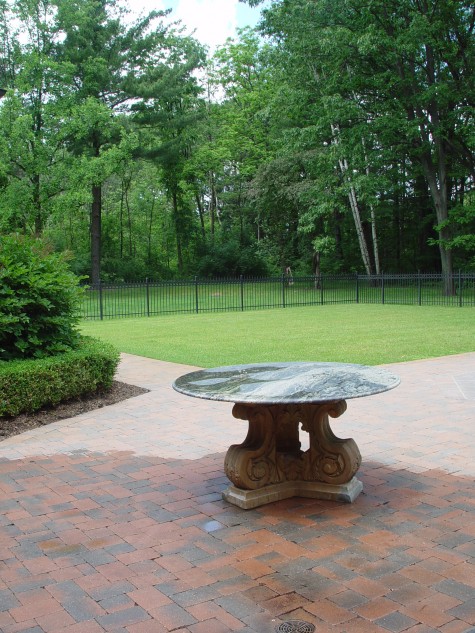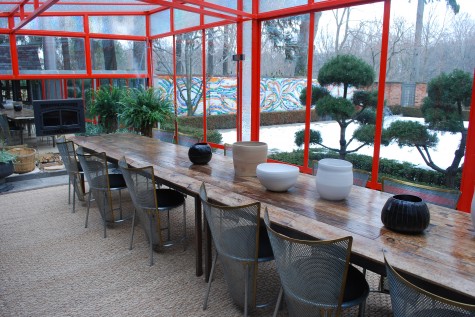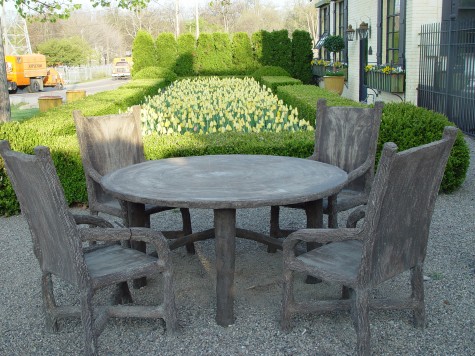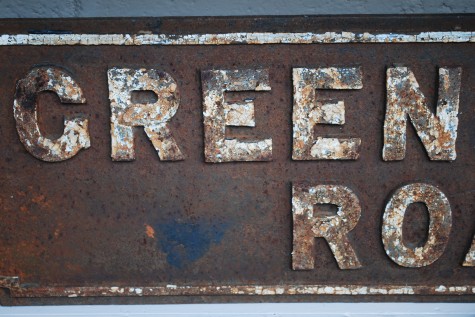
Every three dimensional object has a surface of one sort or another. The dictionary defines surface as the outer or topmost boundary of a 3-D object, the external aspect of an object, or a portion of space having length and breadth but no width. How unhelpful is this? It seems simpler to just think of the surface of an object as its skin. That skin can be represented by different textures. Paintings have subject matter, composition, color, line, mass-a whole raft of qualities. But how the artist physically handles the paint determines its surface. I happen to be thinking about surfaces, as I had someone ask me recently why I did not carry fiberglass or plastic pots and ornament.
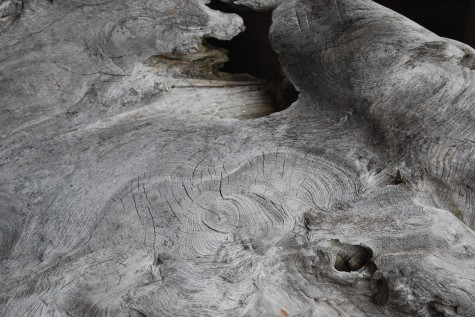
Most of my reasons have to do with a love and interest in what nature has created. Natural materials-wood, terra cotta, stone, dirt, leaves, flowers, water-are living materials. That life imparts a beauty to them like nothing else can. It might be a stretch to think of stone as living and breathing, but I do. It makes emotional sense to me that my garden and landscape be kept company with objects made from natural materials. I once taught a class in vegetable gardening for the Greening of Detroit; I did recommend that anyone worried that their natural soil was contaminated, think about planting their tomatoes and potatoes in garbage cans. Were they old enough to be split at the bottom, or have gashes in the sides, all the better for the drainage. But if I have a choice, I favor the real thing.
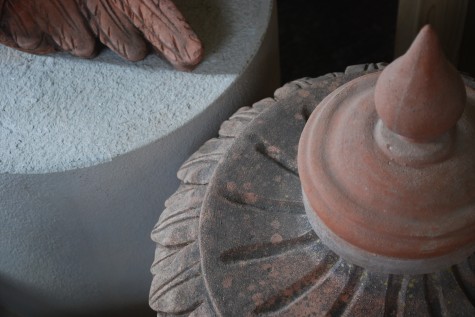
Terra cotta, absorptive as it is, can provide a home for other living organisms such as mosses and lichens; no wonder old terra cotta is my favorite material for pots. The combination of plants and terra cotta is naturally beautiful. I have no objection to made-made materials, as long as they are manufactured to look like what they really are. Fiberglass or plastic made in imitation of any natural material always looks like an imitation. Fiberglas pots made with an unabashedly natural fiberglass surface can be very good looking.
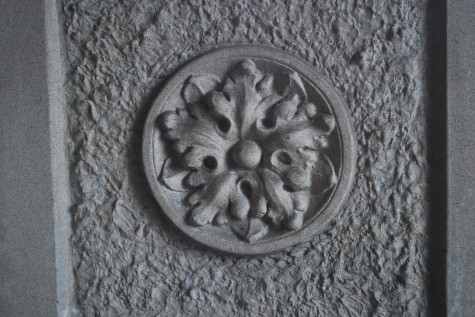 Pictured above is a panel of a terra cotta square pot made by the Galloway Company from Philadelphia Pennsylvania in the early 20th century. The river bottom clay from whence their pots were made is naturally this color. There is no mistaking this is a natural material, even if you have never seen anything made from cream colored clay. The surface is genuine; it rings right.
Pictured above is a panel of a terra cotta square pot made by the Galloway Company from Philadelphia Pennsylvania in the early 20th century. The river bottom clay from whence their pots were made is naturally this color. There is no mistaking this is a natural material, even if you have never seen anything made from cream colored clay. The surface is genuine; it rings right.
 Do you even have a number in mind for all the different kinds of leaves that must exist? Their surfaces can be hairy, shiny, matte, smooth-there is no end of variation. But what they all have in common are surfaces that are unmistakeably alive. They live and breathe. I could not really explain what it is about a living surface that is so evident. Suffice it to say that I have yet to see an imitation that was truly convincing.
Do you even have a number in mind for all the different kinds of leaves that must exist? Their surfaces can be hairy, shiny, matte, smooth-there is no end of variation. But what they all have in common are surfaces that are unmistakeably alive. They live and breathe. I could not really explain what it is about a living surface that is so evident. Suffice it to say that I have yet to see an imitation that was truly convincing.
 Concrete is a man made material which I greatly like. These terra cotta oyster floats have blobs of concrete which help to weigh the floats down in the water. Concrete as a material is at its most beautiful when its surface accurately represents exactly what it is-concrete. Of course everyone has had to make concessions of one kind or another over their garden. I myself have concrete terra cotta pots made in the style of classical Italian terra cotta. I have three places where I wanted a pot in situ 12 months of the year. My concrete pots enable this. Their workmanship is incredibly good. However nothing moves me more than the clay.
Concrete is a man made material which I greatly like. These terra cotta oyster floats have blobs of concrete which help to weigh the floats down in the water. Concrete as a material is at its most beautiful when its surface accurately represents exactly what it is-concrete. Of course everyone has had to make concessions of one kind or another over their garden. I myself have concrete terra cotta pots made in the style of classical Italian terra cotta. I have three places where I wanted a pot in situ 12 months of the year. My concrete pots enable this. Their workmanship is incredibly good. However nothing moves me more than the clay.
 Steel and iron are likewise a product of human technology. The surface of steel will age, as it corrodes. The pits in the surface can provide a home for small plants, just like terra cotta. How steel ages can be very beautiful; age on a man made surface greatly enhances its appearance.
Steel and iron are likewise a product of human technology. The surface of steel will age, as it corrodes. The pits in the surface can provide a home for small plants, just like terra cotta. How steel ages can be very beautiful; age on a man made surface greatly enhances its appearance.
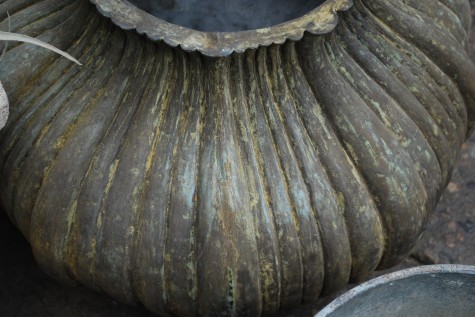 The surface of this terra cotta pot looks like a painting. I have no idea how it was done, but there is no evidence of paint. Whatever altered the surface has soaked in, and become part of the clay. I am told the material is mineral based-as are many pigments.This treatment I can live with. The shape and texture of this pot is beautiful as well-it reminds me of a squash, without trying to look like a squash.
The surface of this terra cotta pot looks like a painting. I have no idea how it was done, but there is no evidence of paint. Whatever altered the surface has soaked in, and become part of the clay. I am told the material is mineral based-as are many pigments.This treatment I can live with. The shape and texture of this pot is beautiful as well-it reminds me of a squash, without trying to look like a squash.
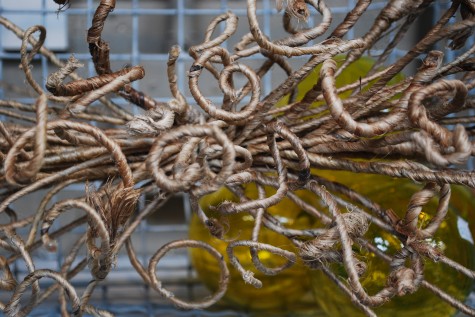
This very heavy gauge wire is wrapped with hemp twine; the wires originally formed stems for some wood shaving flowers. I think I liked these stems better than the flowers, so I saved the stems. I took giant needle nose pliers and secured all 20 stems in the middle with the 21st stem. After curling the ends, I had myself a decent looking bow. Natural materials-I like having them around me.
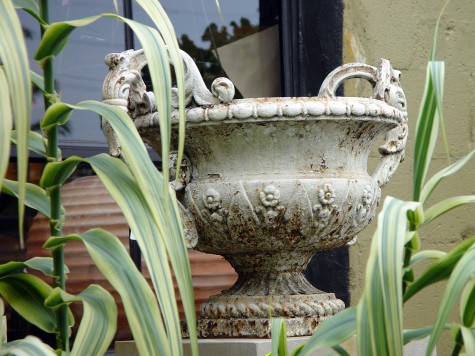 Gardeners make choices based on lots of issues, but most can figure out what appeals to them straight off. Some love old crusty, rusty and well worn antiques; others find that state of gentle disrepair lacks visual punch. Many antique urns have been painted at one time or another; white having been a very popular color. Worn white will either be just the thing, or seem jarring. For others, the prospect of a classical urn leaves them cold-old or new. But if the idea of an urn resonates with you, which you will choose depends on several things.
Gardeners make choices based on lots of issues, but most can figure out what appeals to them straight off. Some love old crusty, rusty and well worn antiques; others find that state of gentle disrepair lacks visual punch. Many antique urns have been painted at one time or another; white having been a very popular color. Worn white will either be just the thing, or seem jarring. For others, the prospect of a classical urn leaves them cold-old or new. But if the idea of an urn resonates with you, which you will choose depends on several things. 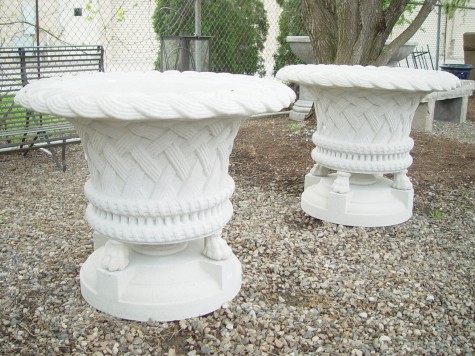 Dry cast limestone urns are usually based on classical handcarved limestone designs dating back hundreds of years. Many of those designs are European in origin. Dry cast limestone is a process by which limestone dust is mixed with a binder, and poured into molds. These reproductions are much more affordable than their antique counterparts. Some old designs would not be available at all, but for a reproduction. On occasion I find a piece I feel I must have, with no placement in mind. But a classical European urn may be very much out of place in front of a Cape Cod home. Now would these elaborately footed urns ring right against the backdrop of my own arts and crafts style home. However, they might be elegant and unexpectedly beautiful in a contemporary setting. The location you have in mind should influence your decision.
Dry cast limestone urns are usually based on classical handcarved limestone designs dating back hundreds of years. Many of those designs are European in origin. Dry cast limestone is a process by which limestone dust is mixed with a binder, and poured into molds. These reproductions are much more affordable than their antique counterparts. Some old designs would not be available at all, but for a reproduction. On occasion I find a piece I feel I must have, with no placement in mind. But a classical European urn may be very much out of place in front of a Cape Cod home. Now would these elaborately footed urns ring right against the backdrop of my own arts and crafts style home. However, they might be elegant and unexpectedly beautiful in a contemporary setting. The location you have in mind should influence your decision.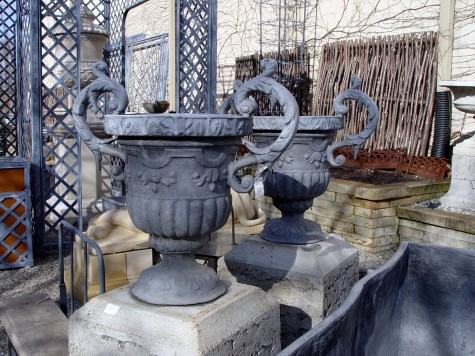 The scale of an urn is an important consideration. Very small urns may need pedestals to set them off properly. If the shape and decoration of an urn is a good bit of what you find appealing, then they need be placed where those things can be easily seen. Small urns have another significant disadvantage. From a small size follows a small planting area; you will need to edit your plant choices. Perhaps of more importance-how easily will you be able to water, and water again, when the weather gets hot? Small pots dry out faster than is easy to keep up with.
The scale of an urn is an important consideration. Very small urns may need pedestals to set them off properly. If the shape and decoration of an urn is a good bit of what you find appealing, then they need be placed where those things can be easily seen. Small urns have another significant disadvantage. From a small size follows a small planting area; you will need to edit your plant choices. Perhaps of more importance-how easily will you be able to water, and water again, when the weather gets hot? Small pots dry out faster than is easy to keep up with.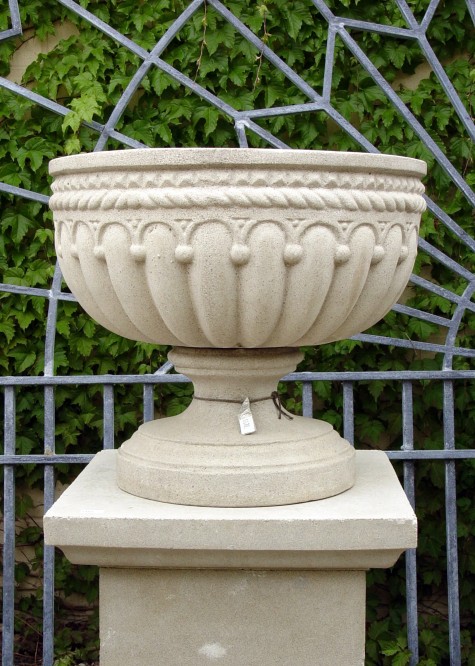 I like urns of a generous size. I have plenty of room to plant-either lots of one thing, or a collection. An urn planted such that in late summer it is a garden bouquet of good size is a pleasure. Watered properly, they retain moisture evenly, over a longer period of time. A container that can wait for me to get there with the hose- this I appreciate. Any urn I plant becomes part of the working garden. A gorgeous urn with a poor planting is a frustration no gardener needs.
I like urns of a generous size. I have plenty of room to plant-either lots of one thing, or a collection. An urn planted such that in late summer it is a garden bouquet of good size is a pleasure. Watered properly, they retain moisture evenly, over a longer period of time. A container that can wait for me to get there with the hose- this I appreciate. Any urn I plant becomes part of the working garden. A gorgeous urn with a poor planting is a frustration no gardener needs. 
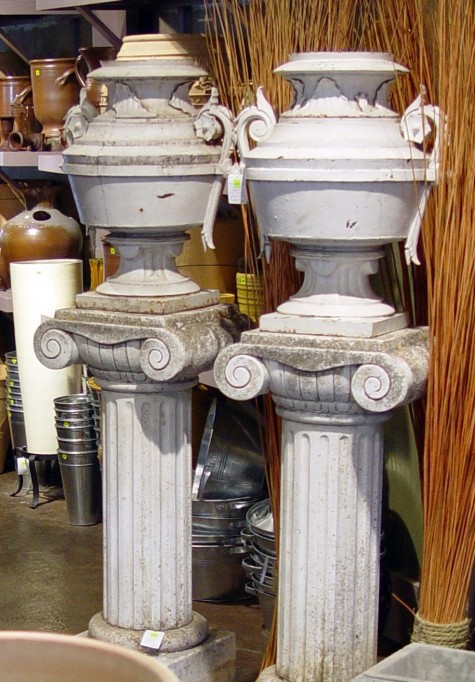 These French art deco style urns have such style and presence one might be inclined not to plant them. The Waterloo Urn I discussed in yesterday’s post is placed out in the open landscape. Unplanted, it could be placed anywhere calling for a sculpture-no need to have water conveniently nearby.
These French art deco style urns have such style and presence one might be inclined not to plant them. The Waterloo Urn I discussed in yesterday’s post is placed out in the open landscape. Unplanted, it could be placed anywhere calling for a sculpture-no need to have water conveniently nearby. 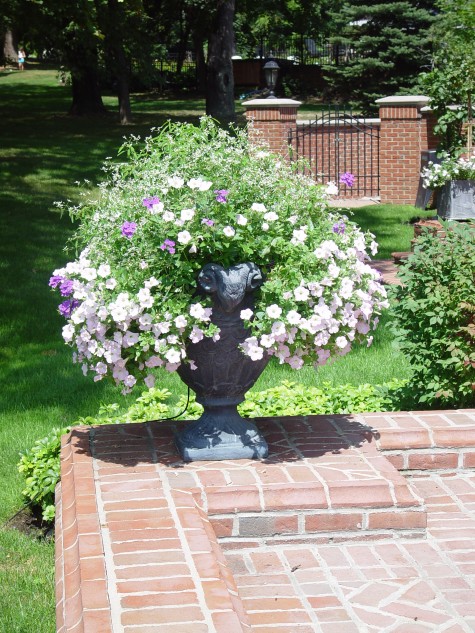 This lead urn is watered via a tube connected to the irrigation system in this yard. In much the same way as greenhouses tube their hanging baskets, or geraniums, these tubes buy a gardener a little time. They are not really a substitue for hand watering, as the coverage can be uneven, too long, or too short. If the tube runs on a nearby irrigation zone, that pot is at the water mercy of whatever else is being primarily watered. I am more than willing to look after my plantings; some automatic irrigation helps me to hedge this pledge. Those days that I come home really late will not need be a crisis. The level of your ability to maintain pot plantings is an important part of the selection process.
This lead urn is watered via a tube connected to the irrigation system in this yard. In much the same way as greenhouses tube their hanging baskets, or geraniums, these tubes buy a gardener a little time. They are not really a substitue for hand watering, as the coverage can be uneven, too long, or too short. If the tube runs on a nearby irrigation zone, that pot is at the water mercy of whatever else is being primarily watered. I am more than willing to look after my plantings; some automatic irrigation helps me to hedge this pledge. Those days that I come home really late will not need be a crisis. The level of your ability to maintain pot plantings is an important part of the selection process.  These concrete pots are English made reproductions, but they have that aged look. The surface is such that I would plant the tall, and vase shaped-nothing trailing. Ala some voluminously opulent Flemish flower painting. There is no choosing these pots if the decorative story being told does not greatly appeal-why cover up what so appealed to you in the first place? In this case, the urns and there plantings need to strike a balance, so they look great in relationship to one another.
These concrete pots are English made reproductions, but they have that aged look. The surface is such that I would plant the tall, and vase shaped-nothing trailing. Ala some voluminously opulent Flemish flower painting. There is no choosing these pots if the decorative story being told does not greatly appeal-why cover up what so appealed to you in the first place? In this case, the urns and there plantings need to strike a balance, so they look great in relationship to one another. 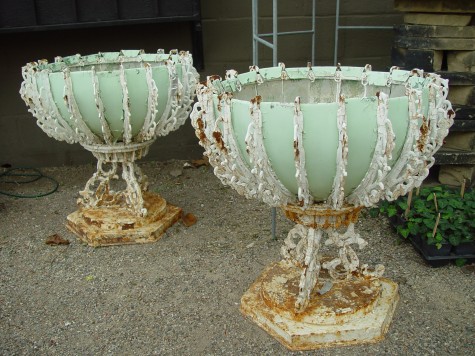
![1660164496_ce85d76e9b_o[1] 1660164496_ce85d76e9b_o[1]](https://deborahsilver.com/wp-content/uploads/2010/02/1660164496_ce85d76e9b_o1.jpg)
![15a1[1] 15a1[1]](https://deborahsilver.com/wp-content/uploads/2010/02/15a11.jpg) When I first got interested in dealing in garden antiques, it was tough going- educating myself about them. Outside of a few well known reference books, garden auction catalogues proved helpful. A garden urn, I learned, is a container with a foot, or pedestal. The small urn pictured above was manufactured by the Coalbrookdale Ironworks in England in the 19th century, and is a handsomely proportioned piece.
When I first got interested in dealing in garden antiques, it was tough going- educating myself about them. Outside of a few well known reference books, garden auction catalogues proved helpful. A garden urn, I learned, is a container with a foot, or pedestal. The small urn pictured above was manufactured by the Coalbrookdale Ironworks in England in the 19th century, and is a handsomely proportioned piece. ![C0671[1] C0671[1]](https://deborahsilver.com/wp-content/uploads/2010/02/C06711.jpg)
![256[1] 256[1]](https://deborahsilver.com/wp-content/uploads/2010/02/2561.jpg)
![831[1] 831[1]](https://deborahsilver.com/wp-content/uploads/2010/02/8311.jpg) These American concrete urns on associated pedestals came from the Philadelphia area. They are among the most favorite garden urns that have ever come my way. The bell shape is decorated with what seems like thistles to me. I know little else about them. They are in very fragile condition; I bring them in for the winter. Their rims have been so worn by rain and exposure to the elements that I can see the aggregate in the concrete mix clearly. Stately and frail, they are.
These American concrete urns on associated pedestals came from the Philadelphia area. They are among the most favorite garden urns that have ever come my way. The bell shape is decorated with what seems like thistles to me. I know little else about them. They are in very fragile condition; I bring them in for the winter. Their rims have been so worn by rain and exposure to the elements that I can see the aggregate in the concrete mix clearly. Stately and frail, they are.![C1311[1] C1311[1]](https://deborahsilver.com/wp-content/uploads/2010/02/C13111.jpg) These diminuitive concrete urns have a highly textured surface, just like my thistle urns. They are old-vintage-pieces, not antiques. The faded red color is unusual, and the shape is beautiful. I could easily see them indoors. Old garden urns are fine unplanted. They have an aura and a presence that needs nothing else, should the sculpture alone please you.
These diminuitive concrete urns have a highly textured surface, just like my thistle urns. They are old-vintage-pieces, not antiques. The faded red color is unusual, and the shape is beautiful. I could easily see them indoors. Old garden urns are fine unplanted. They have an aura and a presence that needs nothing else, should the sculpture alone please you.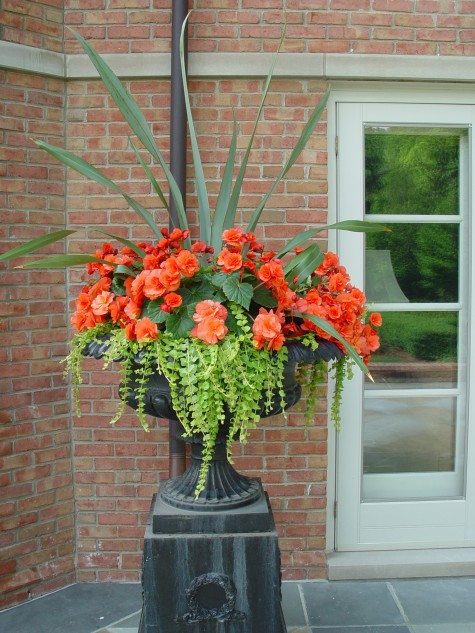
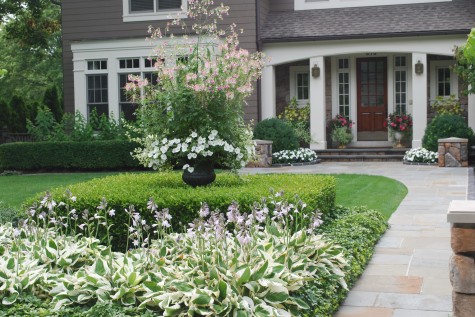
 My own Italian terra cotta garden urns on plinths from Mital-I so love them. I trim what ever obscures their decoration. In the winter, I move them to my front porch, and plant them for the holidays. The rest of the winter they are empty, awaiting spring.
My own Italian terra cotta garden urns on plinths from Mital-I so love them. I trim what ever obscures their decoration. In the winter, I move them to my front porch, and plant them for the holidays. The rest of the winter they are empty, awaiting spring. 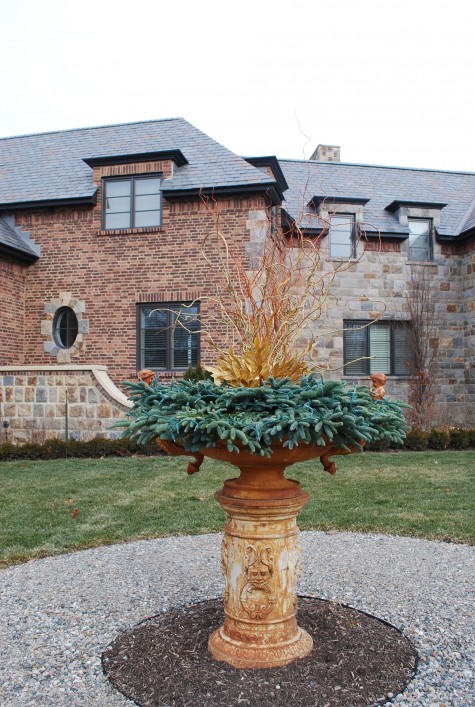 Antique urns take to a winter planting with ease. This client landscaped her yard to celebrate her fine antique footed pots. I completely understand this gesture.
Antique urns take to a winter planting with ease. This client landscaped her yard to celebrate her fine antique footed pots. I completely understand this gesture. 
